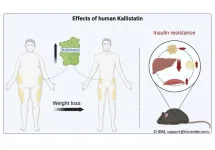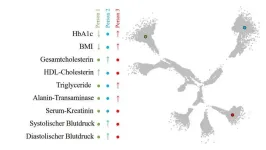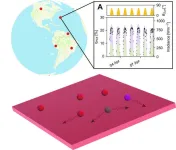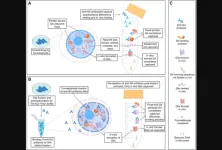(Press-News.org) Although prevention and treatment strategies are available for influenza, they are not sufficient for vulnerable populations such as young children and newborns. In a new study, published in Virology, a multidisciplinary team of researchers have studied newborn piglets to better understand the progression of influenza infections.
The influenza A virus can infect a variety of birds and mammals, including humans and pigs, due to which it is a threat to public health and food security. While it causes mild to moderate infections in healthy individuals, susceptible human populations are at a higher risk. Even though vaccines and therapeutics are available, they are either less effective or they cannot be used in newborns and infants.
“Previous studies have looked at mice models, but compared to mice, pigs are a better model especially for studying immunity,” said Ying Fang (CGD/MMG), a professor of veterinary medicine. “This study is an extension of what we did in the past, where we looked at the effect of maternal immunity on piglets. It is the first study to use neonatal piglet models to elucidate the interactions between the host microbiota and the influenza virus.”
The respiratory tract in mammals is home to millions of microorganisms—collectively known as the microbiota. Other research groups have found that the microbiota can dictate an individual’s susceptibility to respiratory infections, either by improving immunity or making the infections worse.
To understand the interactions between the virus and the microbiota, the researchers used four types of viruses that differed based on their ability to cause disease. They introduced these virus suspensions drop-by-drop into each nostril of the piglets and monitored them for 5 days to see whether they displayed any symptoms, including changes in body temperature. The researchers also used nasal swabs to sample the microorganisms that were present at the beginning of the infection and after 5 days.
The team found that certain bacterial species, including Staphylococcus, were associated with the presence of lung lesions, higher rectal temperature, and viral loads, while others, such as Lactobacillus and Megasphaera, had the opposite effect. These results are in agreement with other studies that have shown that Staphylococcus is linked to inflammation and infection in other influenza and COVID-19 models.
“It is possible that microbes are mediating the impact of the virus on the host,” said Christopher Gaulke (MME), an assistant professor of pathobiology. “This means that we could potentially prevent some of the damaging impacts of these infections by providing animals or even humans with probiotic microbes that could be protective.”
They also found that regardless of what microbes were present on the first day, the infection disrupted the numbers and types of bacteria that were present in the nasal passages.
“These results suggest that by looking at the microbiota, we can predict whether a pig is infected regardless of the infecting virus strain. Although it might not be the best diagnostic tool at the moment, because it is relatively expensive, falling costs and improvements in statistical approaches could soon lead to low-cost microbiome-based diagnostics of swine health. It also highlights the possibility that we could use microbiome-based therapeutics to mitigate the impacts of influenza,” Gaulke said.
The researchers are now interested in lengthening the duration of the study to observe the long-term changes in the microbial composition.
“In this study, we focused on the acute phase of infection, so we don’t know the long-term impact: how long they take to recover the original levels of the microorganisms and whether they recover completely and resemble the uninfected pigs,” Fang said.
“We will also need to test whether these results hold in swine farms and whether they can implement anything that we come up with in our experimental barns,” Gaulke said. “Down the road, it would be interesting to see if these sorts of changes occur in human infants that are infected with influenza virus.”
The study “A neonatal piglet model reveals interactions between nasal microbiota and influenza A virus pathogenesis” can be found at https://doi.org/10.1016/j.virol.2024.109996. The work was supported by the National Institutes of Health and the University of Illinois Urbana-Champaign.
END
Newborn piglets serve as a model for studying influenza
2024-03-18
ELSE PRESS RELEASES FROM THIS DATE:
Kallistatin contributes to the beneficial metabolic effects of weight loss
2024-03-18
After weight loss, people with overweight and obesity express more of the protein Kallistatin* in subcutaneous white adipose tissue. This was demonstrated by researchers from the DZD in a recent study. In addition, Kallistatin improves metabolism and could open up new therapeutic options for people with obesity and type 2 diabetes in future. The results have now been published in Molecular Metabolism.
An increasing number of people are developing type 2 diabetes and obesity. These are highly complex and multifaceted diseases. In order to treat them sustainably, new approaches to therapy are needed. Clinical studies on humans have ...
WashU engineers manage a first: measuring pH in cell condensates
2024-03-18
Scientists trying to understand the physical and chemical properties that govern biomolecular condensates now have a crucial way to measure pH and other emergent properties of these enigmatic, albeit important cellular compartments.
Condensates are communities of proteins and nucleic acids. They lack a membrane and come together and fall apart as needed. The nucleolus is a prominent condensate in cells. It serves vital roles in cellular physiology and is the site of ribosome production.
Ribosomes are the multi-protein ...
Study with innovative insights into the heterogeneity of type 2 diabetes
2024-03-18
A landmark study by the German Diabetes Center (DDZ), published in The Lancet Diabetes & Endocrinology, sheds new light on the heterogeneity of type 2 diabetes. The researchers employed an innovative algorithm to stratify people with type 2 diabetes using routine data and thus visualize the metabolic diversity of diabetes.
Type 2 diabetes is a disease with highly diverse progression pathways. Using an innovative algorithm, a team led by the German Diabetes Center (DDZ) used routinely measured variables to open up new perspectives on the diversity of type 2 diabetes in terms of insulin sensitivity, insulin secretion, ...
Breakthrough in melting point prediction: over 100-year-old physics problem solved by Queen Mary Professor
2024-03-18
A longstanding problem in physics has finally been cracked by Professor Kostya Trachenko of Queen Mary University of London's School of Physical and Chemical Sciences. His research, published in the Physical Review E, unveils a general theory for predicting melting points, a fundamental property whose understanding has baffled scientists for over a century.
For decades, our understanding of the three basic states of matter – solids, liquids, and gases – relied on temperature-pressure phase diagrams. These diagrams depict the conditions under which each state exists, with distinct lines separating them. However, one crucial line, ...
Shining a light on the underpinnings of rare disease impacting children
2024-03-18
A team from the University of Ottawa's Faculty of Medicine has completed an exciting new study that reveals the inner workings of gene mutations that result in an ultra-rare syndrome with fewer than 100 reported cases since its first description in the early 1960s.
The hard-won research discovery may accelerate the development of a treatment for Borjeson-Forssman-Lehmann Syndrome (BFLS), a neurodevelopmental disorder linked to the X chromosome that’s characterized by seizures, intellectual disability, and behavioural ...
Landmark study shows that ‘transcendent’ thinking may grow teens’ brains over time
2024-03-18
Scientists at the USC Rossier School of Education’s Center for Affective Neuroscience, Development, Learning and Education (CANDLE), have shown for the first time that a type of thinking, that has been described for over a century as a developmental milestone of adolescence, may grow teenagers’ brains over time. This kind of thinking, which the study’s authors call “transcendent,” moves beyond reacting to the concrete specifics of social situations to also consider ...
Reimagining the future of solar energy
2024-03-18
Scientists are always on the lookout for ways to make our world a better place, and one area they're focusing on is solar energy. One idea in this area is to make solar cells more efficient by concentrating more solar light onto them. While investigating this recently, a group of scientists at the Cavendish Laboratory and AMOLF (Amsterdam NL) have found that improving solar cells efficiency in this way is harder than we might think but have discovered other avenues by which it might be possible to improve solar energy capture anywhere on the planet.
The researchers ...
Metformin during pregnancy impacts offspring brain development
2024-03-18
With the rise in gestational diabetes and metabolic disorders during pregnancy, metformin is also being prescribed more frequently. Although it is known that the oral antidiabetic agent can cross the placental barrier, the impacts on the brain development of the child are largely unknown. An interdisciplinary research team from the German Institute of Human Nutrition Potsdam-Rehbrücke (DIfE) have now been able to demonstrate in a mouse model that although metformin has positive effects in pregnant animals, it does not in the offspring. The results were published in the specialist ...
Johns Hopkins Medicine-led team develops fluid biomarker for early detection of ALS and FTD
2024-03-18
Two progressively degenerative diseases, amyotrophic lateral sclerosis (ALS, commonly known as Lou Gehrig’s disease) and frontotemporal dementia (FTD, recently in the news with the diagnoses of actor Bruce Willis and talk show host Wendy Williams), are linked by more than the fact that they both damage nerve cells critical to normal functioning — the former affecting nerves in the brain and spinal cord leading to loss of movement, the latter eroding the brain regions controlling personality, behavior and language.
Research studies have repeatedly shown that in patients with ALS or FTD, the function of TAR DNA-binding protein 43, more commonly called TDP-43, ...
A new antibody capture method reveals G-quadruplex landscape and its regulation
2024-03-18
“[...] we present an improved method for G4 landscape determination and by applying it we show that sequence property-specific constraints of the nuclear environment mitigate G4 formation.”
BUFFALO, NY- March 18, 2024 – A new research paper was published in Oncotarget's Volume 15 on March 14, 2024, entitled, “G-quadruplex landscape and its regulation revealed by a new antibody capture method.”
In this new study, researchers Subhamoy Datta, Manthan Patel, Chakkarai Sathyaseelan, Chandrama Ghosh, Akanksha Mudgal, Divyesh Patel, Thenmalarchelvi Rathinavelan, ...







